Sargassum-Modified Asphalt: Effect of Particle Size on Its Physicochemical, Rheological, and Morphological Properties
Abstract
:1. Introduction
2. Materials and Methods
2.1. Materials
2.2. Preparation and Characterization of Asphalt Blends
2.3. Evaluation Methods
2.3.1. Elemental Analysis
2.3.2. FTIR Spectroscopy
2.3.3. Thermogravimetric Analysis
2.3.4. X-ray Diffraction
2.3.5. Conventional Physical Tests
2.3.6. Rheology
2.3.7. Epifluorescence Microscopy
3. Results and Discussion
3.1. Chemical Composition of Sargassum Particles
3.1.1. Elemental Analysis
3.1.2. Infrared Spectroscopy
3.1.3. Thermogravimetry (TGA)
3.1.4. X-ray Diffraction (XRD)
3.2. Effect of SGP on the Complex Modulus of Modified Asphalt
3.3. Effect of the SGP Concentration and Size on the Asphalt Viscosity
3.4. Softening Point of SGP-Asphalt Mixtures
3.5. Storage Stability Test
3.6. Penetration Test
3.7. ANOVA Tests
3.8. Morphology of the SGP Dispersion in the Asphalt Binders
4. Conclusions
Author Contributions
Funding
Institutional Review Board Statement
Informed Consent Statement
Data Availability Statement
Acknowledgments
Conflicts of Interest
References
- AASHTO T315–12: Standard Method of Test for Determining the Rheological Properties of Asphalt Binder Using a Dynamic Shear Rheometer (DSR); AASHTO: Washington, DC, USA, 2016.
- Abdul Khalil, H.P.S.; Tye, Y.Y.; Saurabh, C.K.; Leh, C.P.; Lai, T.K.; Chong, E.W.N.; Nurul Fazita, M.R.; Hafiidz, J.M.; Banerjee, A.; Syakir, M.I. Biodegradable polymer films from seaweed polysaccharides: A review on cellulose as a reinforcement material. Express Polym. Lett. 2017, 11, 244–265. [Google Scholar] [CrossRef]
- Asphalt Institute. Asphalt Binder Testing, Technician’s Manual for Specification Testing of Asphalt Binder. MS-25; Asphalt Institute, EUA: Lexington, KY, USA, 2014. [Google Scholar]
- ASTM D-36-95: Standard Test Method for Softening Point of Bitumen (Ring-and-Ball Apparatus); ASTM: West Conshohocken, PA, USA, 2015.
- Azarhoosh, A.; Koohmishi, M. Investigation of the rutting potential of asphalt binder and mixture modified by styrene-ethylene/propylene-styrene nanocomposite. Constr. Build. Mater. 2020, 255, 119363. [Google Scholar] [CrossRef]
- Bellatrache, Y.; Ziyani, L.; Dony, A.; Taki, M.; Haddadi, S. Effects of the addition of date palm fibers on the physical, rheological and thermal properties of bitumen. Constr. Build. Mater. 2020, 239, 117808. [Google Scholar] [CrossRef]
- Bilema, M.; Aman, M.; Hassan, N.; Haloul, M.; Modibbo, S. Influence of crumb rubber size particles on moisture damage and strength of the hot mix asphalt. Mater. Today Proc. 2021, 42, 2387–2391. [Google Scholar] [CrossRef]
- Cao, Y.; Li, H.; Zhang, Y.; Zhang, J.; He, J. Structure and Properties of Novel Regenerated Cellulose Films Prepared from Cornhusk Cellulose in Room Temperature Ionic Liquids Yan. J. Appl. Polym. Sci. 2010, 116, 2658–2667. [Google Scholar] [CrossRef]
- Caro, S.; Vega, N.; Husserl, J.; Alvarez, A.E. Studying the impact of biomodifiers produced from agroindustrial wastes on asphalt binders. Constr. Build. Mater. 2016, 126, 369–380. [Google Scholar] [CrossRef]
- Chen, J.S.; Lin, K.Y.I. Mechanism and behavior of bitumen strength reinforcement using fibers. J. Mater. Sci. 2005, 40, 87–95. [Google Scholar] [CrossRef]
- Colunga-Sánchez, L.M.; Salazar-Cruz, B.A.; Rivera-Armenta, J.L.; Morales-Cepeda, A.B.; Ramos-Gálvan, C.E.; Chávez-Cinco, M.Y. Evaluation of chicken feather and styrene-butadiene/chicken feather composites as modifier for asphalts binder. Appl. Sci. 2019, 9, 5188. [Google Scholar] [CrossRef] [Green Version]
- Devault, D.A.; Modestin, E.; Cottereau, V.; Vedie, F.; Stiger-Pouvreau, V.; Pierre, R.; Coynel, A.; Dolique, F. The silent spring of Sargassum. Environ. Sci. Pollut. Res. 2021, 28, 15580–15583. [Google Scholar] [CrossRef]
- Devault, D.A.; Pierre, R.; Marfaing, H.; Dolique, F.; Lopez, P.J. Sargassum contamination and consequences for downstream uses: A review. J. Appl. Phycol. 2021, 33, 567–602. [Google Scholar] [CrossRef]
- Ding, Z.; Li, P.; Zhang, J.; Bing, H.; Yue, X. Analysis of viscosity test conditions for crumb-rubber-modified asphalt. Constr. Build. Mater. 2020, 245, 118454. [Google Scholar] [CrossRef]
- Doh, H.; Dunno, K.D.; Whiteside, W.S. Preparation of novel seaweed nanocomposite film from brown seaweeds Laminaria japonica and Sargassum natans. Food Hydrocoll. 2020, 105, 105744. [Google Scholar] [CrossRef]
- Hataf, N.; Ghadir, P.; Ranjbar, N. Investigation of soil stabilization using chitosan biopolymer. J. Clean. Prod. 2018, 170, 1493–1500. [Google Scholar] [CrossRef]
- Ju, X.; Bowden, M.; Brown, E.E.; Zhang, X. An improved X-ray diffraction method for cellulose crystallinity measurement. Carbohydr. Polym. 2015, 123, 476–481. [Google Scholar] [CrossRef] [PubMed] [Green Version]
- Kannan, S. FT-IR and EDS analysis of the seaweeds Sargassum wightii (brown algae) and Gracilaria corticata (red algae). Int. J. Curr. Microbiol. Appl. Sci. 2014, 3, 341–351. [Google Scholar]
- Kim, M.; Buttlar, W.G. Stiffening Mechanisms of Asphalt–Aggregate Mixtures: From Binder to Mixture. Transp. Res. Rec. J. Transp. Res. Board. 2010, 2181, 98–108. [Google Scholar] [CrossRef]
- Kolsi, R.B.A.; Salah HBen Jardak, N.; Chaaben, R.; Jribi, I.; Feki AEl Rebai, T.; Jamoussi, K.; Allouche, N.; Blecker, C.; Belghith, H.; Belghith, K. Sulphated polysaccharide isolated from Sargassum vulgare: Characterization and hypolipidemic effects. Carbohydr. Polym. 2017, 170, 148–159. [Google Scholar] [CrossRef] [PubMed]
- Lee, D.-Y. The Effect of Filler on Asphalt Cement Mastics; Iowa State University of Science and Technology: Ames, IA, USA, 1964. [Google Scholar]
- Li, C.; Zou, J.; Ke, W.; Wang, G.; Li, T.; Li, Y.; Li, S.; Shu, B.; Li, C. Laboratory evaluation of asphalt binder modified by waste carbon particles (WCP) reclaimed from printers. Int. J. Pavement Res. Technol. 2021, 14, 204–212. [Google Scholar] [CrossRef]
- Li, J.; Zhang, F.; Muhammad, Y.; Liu, Y.; Wei, Y.; Chen, H. Fabrication and properties of wide temperature domain pavement seaweed modified bio-bitumen. Constr. Build. Mater. 2019, 227, 117079. [Google Scholar] [CrossRef]
- Luo, G.; James Strong, P.; Wang, H.; Ni, W.; Shi, W. Kinetics of the pyrolytic and hydrothermal decomposition of water hyacinth. Bioresour. Technol. 2011, 102, 6990–6994. [Google Scholar] [CrossRef] [PubMed]
- Martínez-Anzures, J.D.; Zapién-Castillo, S.; Salazar-Cruz, B.A.; Rivera-Armenta, J.L.; del Carmen Antonio-Cruz, R.; Hernández-Zamora, G.; Méndez-Hernández, M.L. Preparation and properties of modified asphalt using branch SBS/nanoclay nanocomposite as a modifier. Road Mater. Pavement Des. 2019, 20, 1275–1290. [Google Scholar] [CrossRef]
- Marx, U.C.; Roles, J.; Hankamer, B. Sargassum blooms in the Atlantic Ocean—From a burden to an asset. Algal Res. 2021, 54, 102188. [Google Scholar] [CrossRef]
- Mohammed, M.; Parry, T.; Grenfell, J. Influence of fibres on rheological properties and toughness of bituminous binder. Constr. Build. Mater. 2018, 163, 901–911. [Google Scholar] [CrossRef]
- Nciri, N.; Shin, T.; Lee, H.; Cho, N. Potential of waste oyster shells as a novel biofiller for hot-mix asphalt. Appl. Sci. 2018, 8, 415. [Google Scholar] [CrossRef] [Green Version]
- Norgbey, E.; Huang, J.; Hirsch, V.; Liu, W.J.; Wang, M.; Ripke, O.; Li, Y.; Takyi Annan, G.E.; Ewusi-Mensah, D.; Wang, X.; et al. Unravelling the efficient use of waste lignin as a bitumen modifier for sustainable roads. Constr. Build. Mater. 2020, 230, 116957. [Google Scholar] [CrossRef]
- Pamplona, T.F.; De CAmoni, B.; De Alencar, A.E.V.; Lima, A.P.D.; Ricardo, N.M.P.S.; Soares, J.B.; De A Soares, S. Asphalt binders modified by SBS and SBS/nanoclays: Effect on rheological properties. J. Braz. Chem. Soc. 2012, 23, 639–647. [Google Scholar] [CrossRef] [Green Version]
- Read, J.; Whiteoak, D. The Shell Bitumen Handbook, 5th ed.; Thomas Telford Publishing: London, UK, 2003. [Google Scholar]
- Rodríguez-Martínez, R.E.; Roy, P.D.; Torrescano-Valle, N.; Cabanillas-Terán, N.; Carrillo-Domínguez, S.; Collado-Vides, L.; García-Sánchez, M.; van Tussenbroek, B.I. Element concentrations in pelagic Sargassum along the Mexican Caribbean coast in 2018–2019. PeerJ 2020, 8, e8667. [Google Scholar] [CrossRef] [Green Version]
- Rodríguez-Muñoz, R.; Muñiz-Castillo, A.I.; Euán-Avila, J.I.; Hernández-Núñez, H.; Valdés-Lozano, D.S.; Collí-Dulá, R.C.; Arias-González, J.E. Assessing temporal dynamics on pelagic Sargassum influx and its relationship with water quality parameters in the Mexican Caribbean. Reg. Stud. Mar. Sci. 2021, 48, 102005. [Google Scholar] [CrossRef]
- Salazar-Cruz, B.A.; Zapien-Castillo, S.; Hernández-Zamora, G.; Rivera-Armenta, J.L. Investigation of the performance of asphalt binder modified by sargassum. Constr. Build. Mater. 2021, 271, 121876. [Google Scholar] [CrossRef]
- Sharifi, K.A.; Pirsa, S. Biodegradable film of black mulberry pulp pectin/chlorophyll of black mulberry leaf encapsulated with carboxymethylcellulose/silica nanoparticles: Investigation of physicochemical and antimicrobial properties. Mater. Chem. Phys. 2021, 267, 124580. [Google Scholar] [CrossRef]
- Shekhar, S.H.S.; Lyons, G.; McRoberts, C.; McCall, D.; Carmichael, E.; Andrews, F.; McCormack, R. Brown seaweed species from Strangford Lough: Compositional analyses of seaweed species and biostimulant formulations by rapid instrumental methods. J. Appl. Phycol. 2012, 24, 1141–1157. [Google Scholar] [CrossRef]
- Sudarshan, M.; Ram, S.S.; Majumdar, S.; Maity, J.P.; Ray, J.G.; Chakraborty, A. Energy-dispersive X-ray fluorescence—A tool for interdisciplinary research. Pramana J.Phys. 2011, 76, 241–247. [Google Scholar] [CrossRef]
- Technical Bulletin DGST No. 2/2020: Origin Asphalt Cement and Classification for Use in Road Infrastructure Works; Secretaría de Comunicaciones y Transportes: Mexico City, Mexico, 2020.
- Thiripura Sundari, M.; Ramesh, A. Isolation and characterization of cellulose nanofibers from the aquatic weed water hyacinth—Eichhornia crassipes. Carbohydr. Polym. 2012, 87, 1701–1705. [Google Scholar] [CrossRef]
- Vanavil, B.; Selvaraj, K.; Aanandhalakshmi, R.; Usha, S.K.; Arumugam, M. Bioactive and thermostable sulphated polysaccharide from Sargassum swartzii with drug delivery applications. Int. J. Biol. Macromol. 2020, 153, 190–200. [Google Scholar]
- Vázquez-Delfín, E.; Freile-Pelegrín, Y.; Salazar-Garibay, A.; Serviere-Zaragoza, E.; Méndez-Rodríguez, L.C.; Robledo, D. Species composition and chemical characterization of Sargassum influx at six different locations along the Mexican Caribbean coast. Sci. Total Environ. 2021, 795, 148852. [Google Scholar] [CrossRef]
- Wang, S.; Wang, Q.; Jiang, X.; Han, X.; Ji, H. Compositional analysis of bio-oil derived from pyrolysis of seaweed. Energy Convers. Manag. 2013, 68, 273–280. [Google Scholar] [CrossRef]
- Wróbel, M.; Woszuk, A.; Ratajczak, M.; Franus, W. Properties of reclaimed asphalt pavement mixture with organic rejuvenator. Constr. Build. Mater. 2021, 271, 121514. [Google Scholar] [CrossRef]
- Yu, H.; Zhu, X.; Qian, G.; Gong, X.; Nie, X. Evaluation of phosphorus slag (PS) content and particle size on the performance modification effect of asphalt. Constr. Build. Mater. 2020, 256, 119334. [Google Scholar] [CrossRef]
- Yu, J.; Zeng, X.; Wu, S.; Wang, L.; Liu, G. Preparation and properties of montmorillonite modified asphalts. Mater. Sci. Eng. A 2007, 447, 233–238. [Google Scholar] [CrossRef]
- Zapién-Castillo, S.; Rivera-Armenta, J.L.; Chávez-Cinco, M.Y.; Salazar-Cruz, B.A.; Mendoza-Martínez, A.M. Physical and rheological properties of asphalt modified with SEBS/montmorillonite nanocomposite. Constr. Build. Mater. 2016, 106, 349–356. [Google Scholar] [CrossRef]
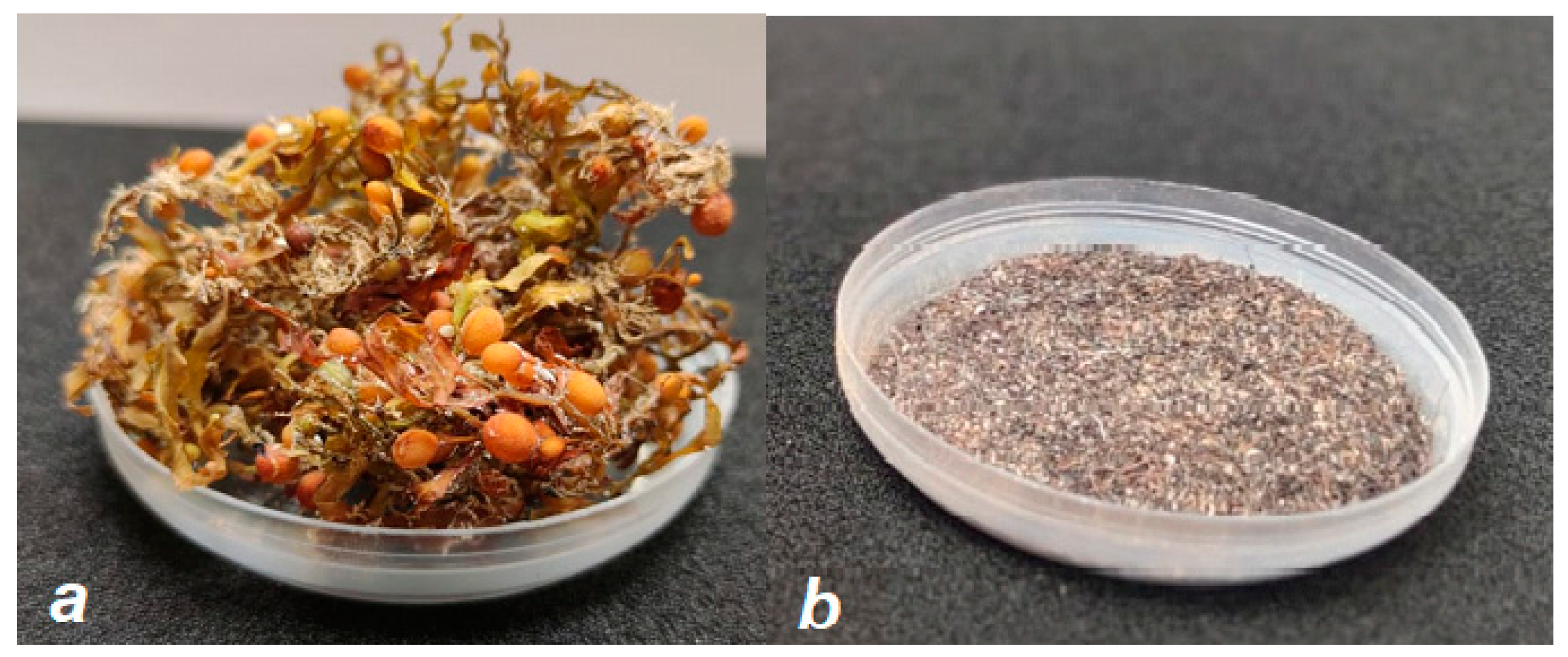

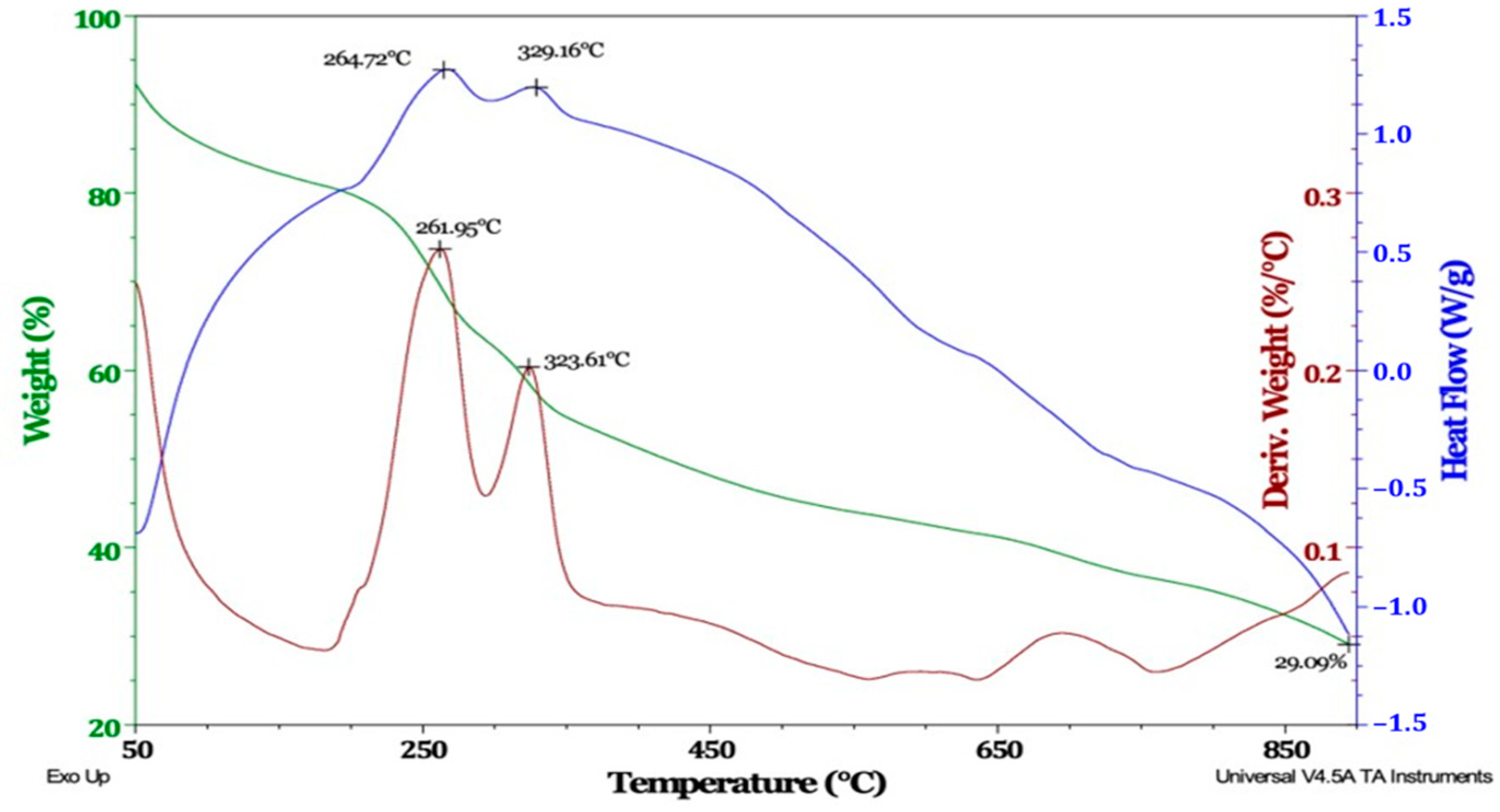
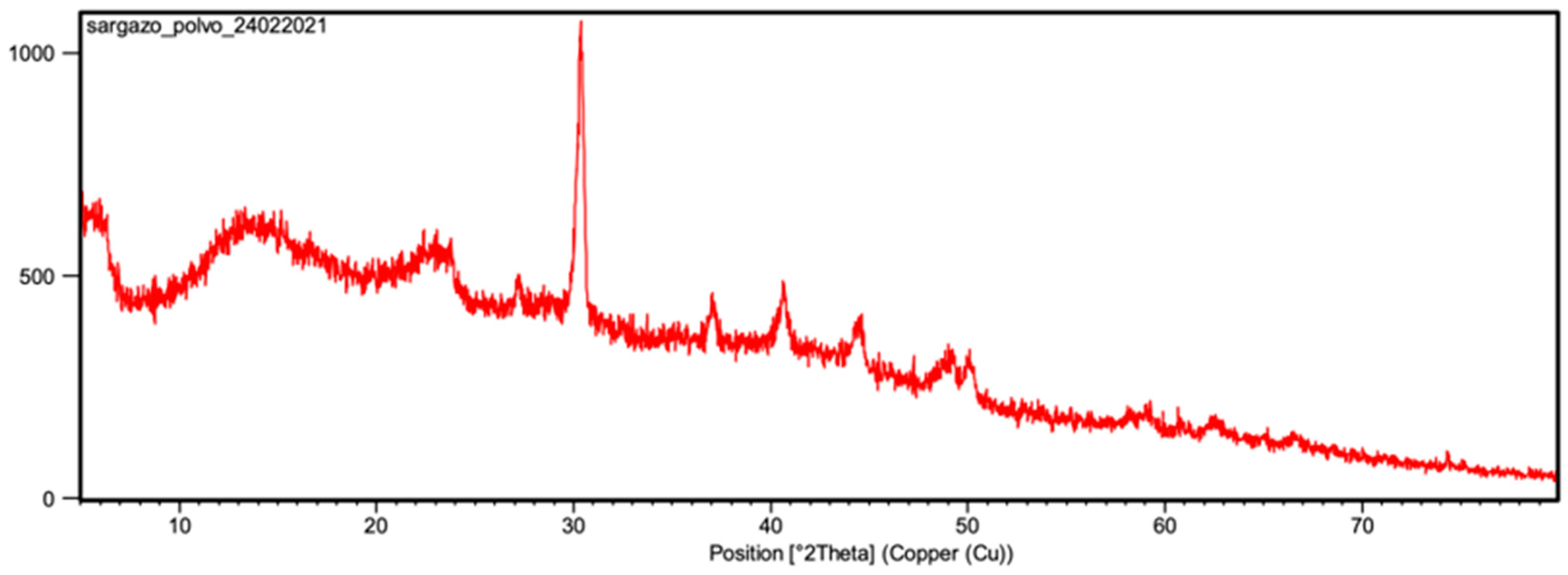



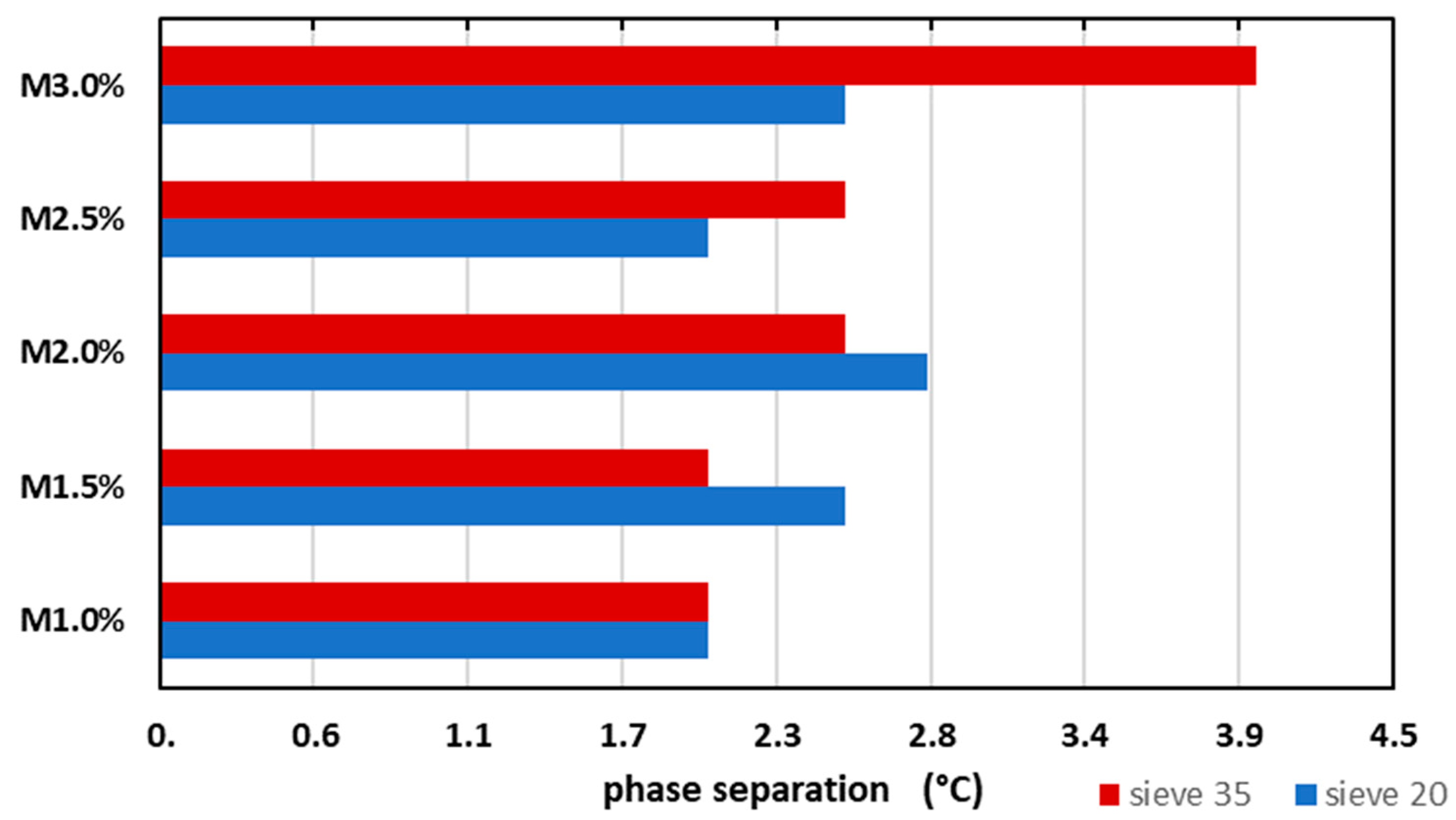


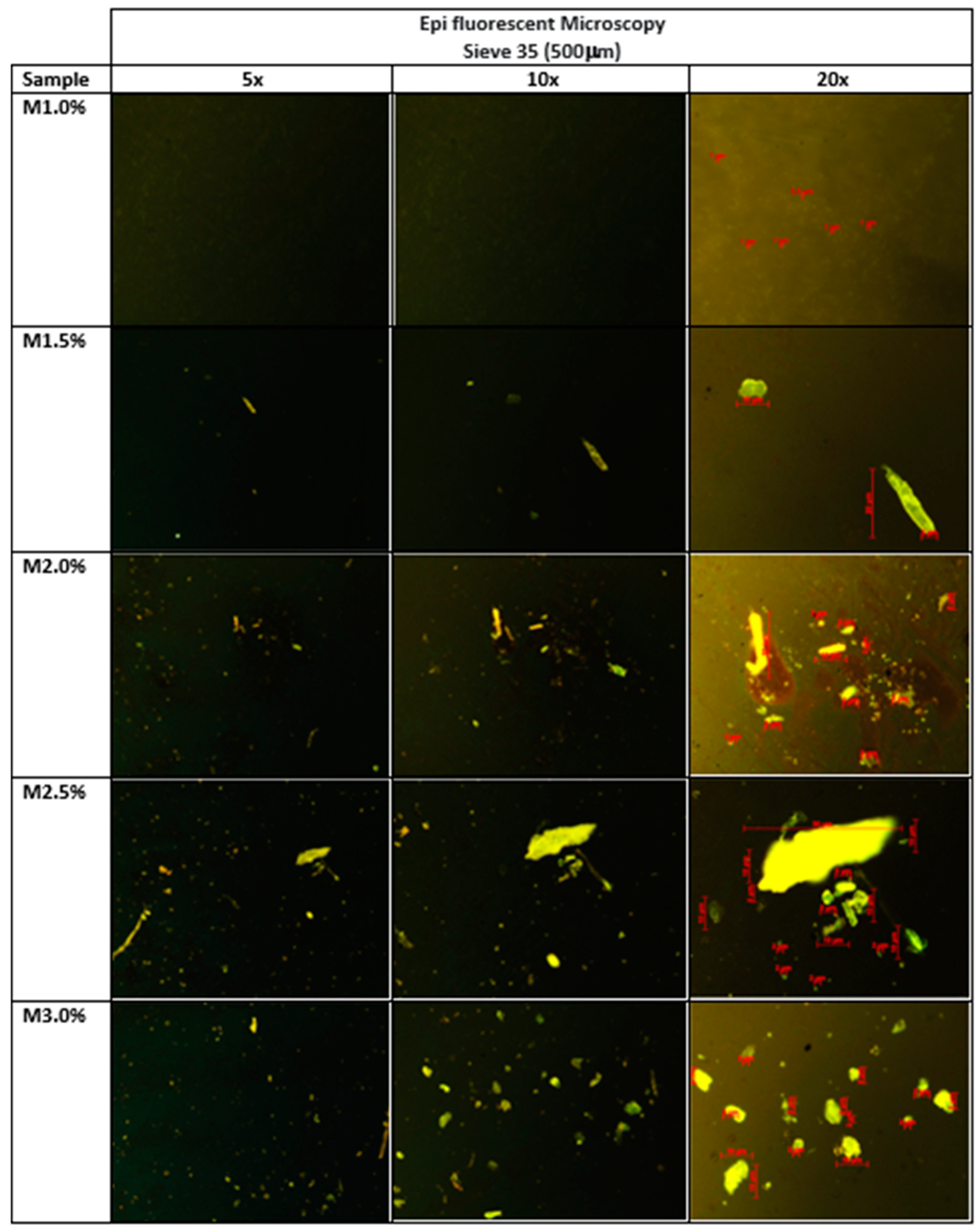
| Property | Unit | Test Method | Value | |
|---|---|---|---|---|
| Penetration | dmm | ASTM D-5 | 55.0 | |
| Softening point | °C | ASTM D-36 | 56.0 | |
| Dynamic Viscosity at 60 °C | Pa.s | ASTM-2171 | 634 | |
| Brookfield Viscosity 50 rpm | 135 °C | cP | ASTM D-4402 | 565 |
| 160 °C | 170 | |||
| 180 °C | 85.0 | |||
| Saturated | % | SARA test | 2.27 | |
| Aromatics | % | 64.43 | ||
| Resins | % | 19.95 | ||
| Asphatenes | % | 13.35 | ||
| Sample Code | Sargassum Content (wt.%) | Sargassum Particle Size (μm) |
|---|---|---|
| M0.0% | 0.0 | -- |
| M1.0%T20 | 1.0 | 850 |
| M1.0%T35 | 1.0 | 500 |
| M1.5%T20 | 1.5 | 850 |
| M1.5%T35 | 1.5 | 500 |
| M2.0%T20 | 2.0 | 850 |
| M2.0%T35 | 2.0 | 500 |
| M2.5%T20 | 2.5 | 850 |
| M2.5%T35 | 2.5 | 500 |
| M3.0%T20 | 3.0 | 850 |
| M3.0%T35 | 3.0 | 500 |
| Anode | Element | Sargassum CountlnMax |
|---|---|---|
| 1-No | Ne | 11.0 |
| Al | 234.0 | |
| Si | 135.0 | |
| P | 185.0 | |
| S | 4710.0 | |
| 2-Ti | Cl | 109.0 |
| K | 261.0 | |
| Ca | 29.0 | |
| Fe | 2.0 | |
| 3-Fe | C | 4.0 |
| Dynamic Viscosity (cP @ 160 °C) | ||
|---|---|---|
| Sample | 20-Mesh Sieve (850 μm) | 35-Mesh Sieve (500 μm) |
| M0.0% | 150.0 | 150.0 |
| M0.0% (aged) | 280.0 | 280.0 |
| M1.0% | 400.0 | 413.0 |
| M1.5% | 500.0 | 513.0 |
| M2.0% | 350.0 | 388.0 |
| M2.5% | 350.0 | 370.0 |
| M3.0% | 325.0 | 345.0 |
| Sample (SGP wt.%) | Penetration Index (PI) | |
|---|---|---|
| 20-Mesh Sieve | 35-Mesh Sieve | |
| M0.0% | −0.2 | −0.2 |
| M1.0% | 0.1 | 0.4 |
| M1.5% | 0.3 | 0.2 |
| M2.0% | 0.6 | 0.1 |
| M2.5% | 0.1 | −0.1 |
| M3.0% | −0.7 | −0.7 |
| Modified Asphalt Property | p-Value | |
|---|---|---|
| SGP wt.% | SGP Particle Size | |
| Complex modulus gain | 0.0000 | 0.0000 |
| Failure temperature | 0.1675 | 0.0512 |
| Dynamic viscosity | 0.0001 | 0.0105 |
| Softening point | 0.0580 | 0.1778 |
| Phase separation | 0.3516 | 0.5385 |
| Penetration index | 0.0301 | 0.4859 |
| Penetration | 0.0667 | 0.4880 |
Publisher’s Note: MDPI stays neutral with regard to jurisdictional claims in published maps and institutional affiliations. |
© 2021 by the authors. Licensee MDPI, Basel, Switzerland. This article is an open access article distributed under the terms and conditions of the Creative Commons Attribution (CC BY) license (https://creativecommons.org/licenses/by/4.0/).
Share and Cite
Escobar-Medina, F.J.; Rivera-Armenta, J.L.; Hernández-Zamora, G.; Salazar-Cruz, B.A.; Zapién-Castillo, S.; Flores-Hernández, C.G. Sargassum-Modified Asphalt: Effect of Particle Size on Its Physicochemical, Rheological, and Morphological Properties. Sustainability 2021, 13, 11734. https://doi.org/10.3390/su132111734
Escobar-Medina FJ, Rivera-Armenta JL, Hernández-Zamora G, Salazar-Cruz BA, Zapién-Castillo S, Flores-Hernández CG. Sargassum-Modified Asphalt: Effect of Particle Size on Its Physicochemical, Rheological, and Morphological Properties. Sustainability. 2021; 13(21):11734. https://doi.org/10.3390/su132111734
Chicago/Turabian StyleEscobar-Medina, Francisco Javier, José Luis Rivera-Armenta, Gabriel Hernández-Zamora, Beatriz Adriana Salazar-Cruz, Samuel Zapién-Castillo, and Cynthia Graciela Flores-Hernández. 2021. "Sargassum-Modified Asphalt: Effect of Particle Size on Its Physicochemical, Rheological, and Morphological Properties" Sustainability 13, no. 21: 11734. https://doi.org/10.3390/su132111734
APA StyleEscobar-Medina, F. J., Rivera-Armenta, J. L., Hernández-Zamora, G., Salazar-Cruz, B. A., Zapién-Castillo, S., & Flores-Hernández, C. G. (2021). Sargassum-Modified Asphalt: Effect of Particle Size on Its Physicochemical, Rheological, and Morphological Properties. Sustainability, 13(21), 11734. https://doi.org/10.3390/su132111734







